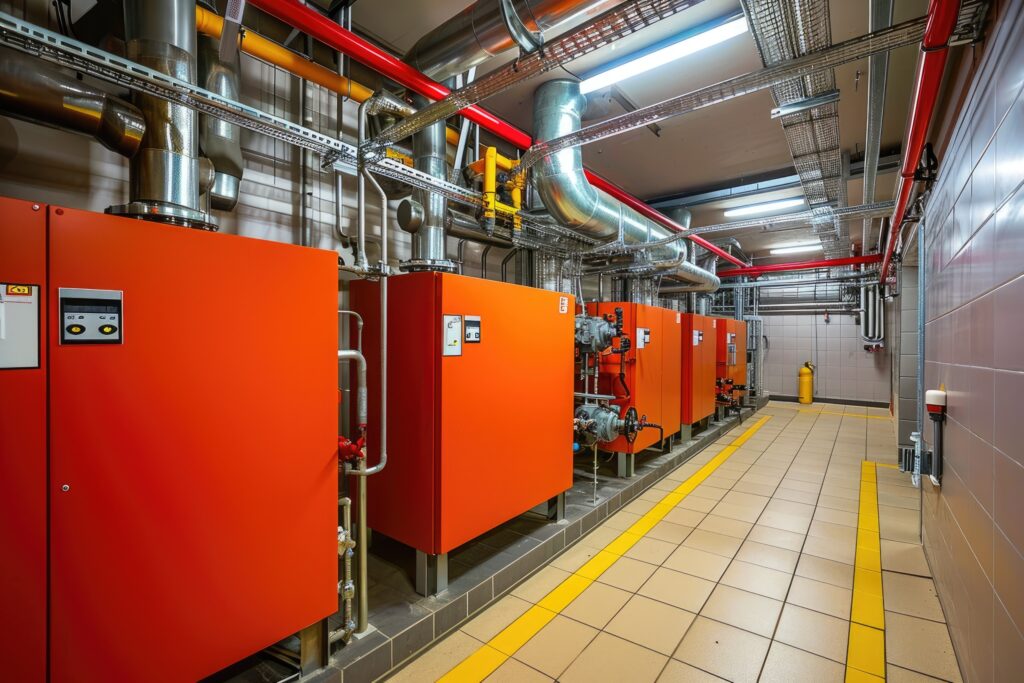Property owners comprehend the importance of temperature control. Not only does a consistent and comfortable indoor environment create a more pleasant experience for employees and customers, but it also affects crucial factors like productivity and sales.
With so much at stake, choosing the right method of heating is a decision that requires thorough research and consideration of key priorities. This article breaks down the main options available and compares their pros, cons, and suitability for different types of spaces.
Radiant Heating
Unlike traditional methods, which blow hot air through ducts, radiant implements a series of panels or tubes installed in the floor, ceiling, or walls to radiate heat throughout the space. This allows for a more even distribution of warmth, with no cold spots or drafts.

Best Commercial Heating Systems for a Building
In addition, since the heat is delivered directly to objects and people in the room, rather than just the air, it can feel more comfortable at lower temperatures. All of these factors make it an excellent choice especially where energy efficiency, comfort, and reliability are of the utmost importance.
Forced-Air Method
One of the main benefits of forced air is that it distributes warm air evenly throughout, ensuring that every corner is heated to the desired temperature. This is particularly important in large spaces with multiple floors and rooms. Additionally, they are relatively easy to install, use less energy, and have low maintenance costs. Most importantly, they can be easily integrated with air conditioning, which makes them a versatile option for businesses that need both heating and cooling. It is no surprise that many building owners swear by them, as it can save them a lot of money in the long run.
Hydronic Plan
Hydronic is quickly becoming the go-to choice for many business owners. Using a closed-loop method that circulates hot water or other fluids through radiators or baseboard heaters, it provides consistent and energy-efficient heat that can effectively warm even the largest of spaces. Not only do they offer many benefits over traditional methods, such as reduced noise pollution and improved indoor air quality, but also they are extremely durable and require minimal maintenance.
Gas and Oil Boilers
Gas and oil boilers generate heat by burning either natural gas or oil, which then heats the water that flows through pipes and radiators. They are highly efficient with most of the heat generated going towards warming up the building. This method is also cost-effective in the long run due to the lower cost of natural gas or oil compared to electricity, and it is also highly durable, meaning it can last for many years without needing much maintenance.
Reasons to Get a Professional to Help You Decide
When it comes to selecting a heating plan, it is important to make the right choice for you and your business. This decision can be complex and overwhelming, as there are many factors to consider, such as the size of your building, your budget, and your specific needs. That is why it is often beneficial to seek professional help when making this decision. By consulting with an expert in this field, you can gain valuable insights into what will work best for your unique situation.
A professional can provide you with personalized recommendations that take into account your specific requirements and objectives. When it comes to such needs, investing in a professional consultant can ultimately lead to greater efficiency, cost savings, and peace of mind. This will be much better compared to when you decide to go the DIY route and make the choice yourself without professional assistance. With an expert, you just need to provide your needs and they will make proper suggestions. You do not have to go into much detail to understand them.
When it comes to heating commercial environments, choosing the right mode can make all the difference. The best are those that balance efficiency, cost, and occupant comfort. One option that has grown in popularity is radiant, which uses panels or tubes to warm surfaces like floors and walls, creating a pleasing, even heat. Another effective choice is forced-air, which uses ducts to distribute warm air throughout the building. Still, others may prefer a hydronic one, which circulates hot water or steam through radiators or piping. In the end, the best depends on your individual needs and the specific constraints of your space. Evaluating the available options and working with an experienced HVAC contractor during the process can help you find a solution that meets your demands.




